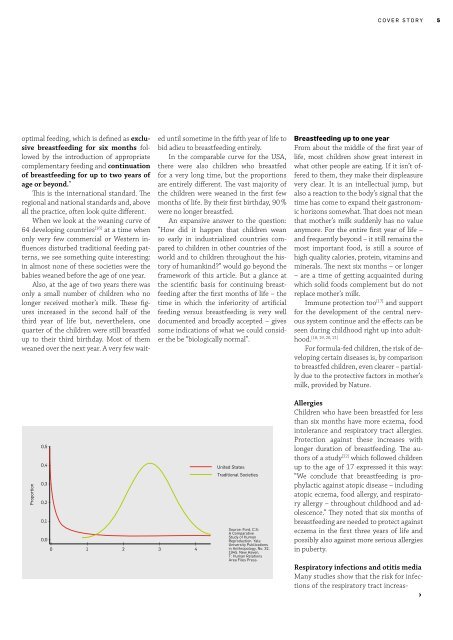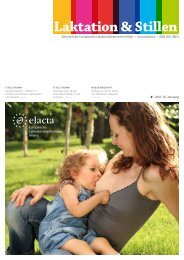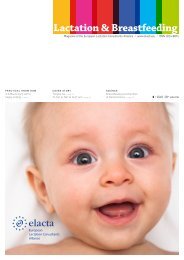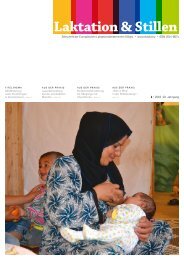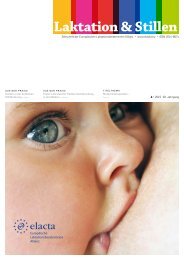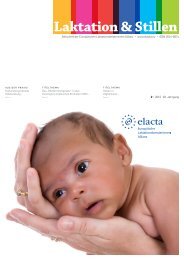Laktation_und_Stillen_2016-3 EN Web p1-10
You also want an ePaper? Increase the reach of your titles
YUMPU automatically turns print PDFs into web optimized ePapers that Google loves.
COVER STORY<br />
5<br />
optimal feeding, which is defined as exclusive<br />
breastfeeding for six months followed<br />
by the introduction of appropriate<br />
complementary feeding and continuation<br />
of breastfeeding for up to two years of<br />
age or beyond.”<br />
This is the international standard. The<br />
regional and national standards and, above<br />
all the practice, often look quite different.<br />
When we look at the weaning curve of<br />
64 developing countries [16] at a time when<br />
only very few commercial or Western influences<br />
disturbed traditional feeding patterns,<br />
we see something quite interesting:<br />
in almost none of these societies were the<br />
babies weaned before the age of one year.<br />
Also, at the age of two years there was<br />
only a small number of children who no<br />
longer received mother’s milk. These figures<br />
increased in the second half of the<br />
third year of life but, nevertheless, one<br />
quarter of the children were still breastfed<br />
up to their third birthday. Most of them<br />
weaned over the next year. A very few waited<br />
until sometime in the fifth year of life to<br />
bid adieu to breastfeeding entirely.<br />
In the comparable curve for the USA,<br />
there were also children who breastfed<br />
for a very long time, but the proportions<br />
are entirely different. The vast majority of<br />
the children were weaned in the first few<br />
months of life. By their first birthday, 90 %<br />
were no longer breastfed.<br />
An expansive answer to the question:<br />
“How did it happen that children wean<br />
so early in industrialized countries compared<br />
to children in other countries of the<br />
world and to children throughout the history<br />
of humankind?” would go beyond the<br />
framework of this article. But a glance at<br />
the scientific basis for continuing breastfeeding<br />
after the first months of life – the<br />
time in which the inferiority of artificial<br />
feeding versus breastfeeding is very well<br />
documented and broadly accepted – gives<br />
some indications of what we could consider<br />
the be “biologically normal”.<br />
Breastfeeding up to one year<br />
From about the middle of the first year of<br />
life, most children show great interest in<br />
what other people are eating. If it isn’t offered<br />
to them, they make their displeasure<br />
very clear. It is an intellectual jump, but<br />
also a reaction to the body’s signal that the<br />
time has come to expand their gastronomic<br />
horizons somewhat. That does not mean<br />
that mother’s milk suddenly has no value<br />
anymore. For the entire first year of life –<br />
and frequently beyond – it still remains the<br />
most important food, is still a source of<br />
high quality calories, protein, vitamins and<br />
minerals. The next six months – or longer<br />
– are a time of getting acquainted during<br />
which solid foods complement but do not<br />
replace mother’s milk.<br />
Immune protection too [17] and support<br />
for the development of the central nervous<br />
system continue and the effects can be<br />
seen during childhood right up into adulthood.<br />
[18, 19, 20, 21]<br />
For formula-fed children, the risk of developing<br />
certain diseases is, by comparison<br />
to breastfed children, even clearer – partially<br />
due to the protective factors in mother’s<br />
milk, provided by Nature.<br />
Proportion<br />
0,5 –<br />
0,4 –<br />
0,3 –<br />
0,2 –<br />
0,1 –<br />
0,0 –<br />
| | | | |<br />
0 1 2 3 4<br />
United States<br />
Traditional Societies<br />
Source: Ford, C.S:<br />
A Comparative<br />
Study of Human<br />
Reproduction. Yale<br />
University Publications<br />
in Anthropology, No. 32,<br />
1945. New Haven,<br />
T: Human Relations<br />
Area Files Press.<br />
Allergies<br />
Children who have been breastfed for less<br />
than six months have more eczema, food<br />
intolerance and respiratory tract allergies.<br />
Protection against these increases with<br />
longer duration of breastfeeding. The authors<br />
of a study [22] which followed children<br />
up to the age of 17 expressed it this way:<br />
“We conclude that breastfeeding is prophylactic<br />
against atopic disease – including<br />
atopic eczema, food allergy, and respiratory<br />
allergy – throughout childhood and adolescence.”<br />
They noted that six months of<br />
breastfeeding are needed to protect against<br />
eczema in the first three years of life and<br />
possibly also against more serious allergies<br />
in puberty.<br />
Respiratory infections and otitis media<br />
Many studies show that the risk for infections<br />
of the respiratory tract increas-<br />
›


